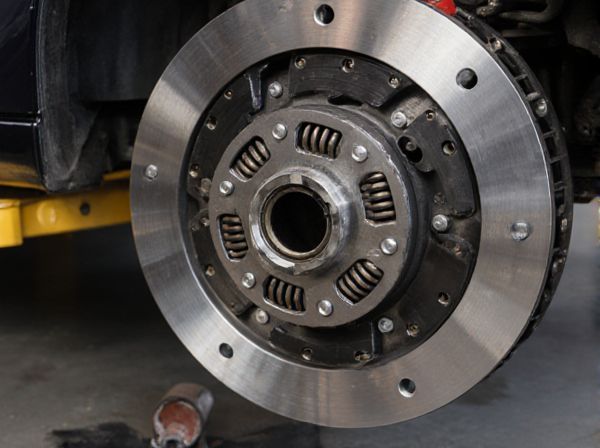
Photo illustration: Positive Clutch vs Friction Clutch
Positive clutches provide a direct mechanical connection between driving and driven components, ensuring zero slippage and precise power transmission ideal for high-torque applications. Friction clutches rely on frictional force generated between contact surfaces to transmit torque, allowing controlled slip and smooth engagement, which is beneficial for preventing damage during startup or speed variations. Your choice depends on whether you prioritize exact synchronization with no slippage (positive clutch) or gradual engagement with variable torque transfer (friction clutch).
Table of Comparison
| Feature | Positive Clutch | Friction Clutch |
|---|---|---|
| Operation | Direct mechanical engagement using interlocking teeth | Engages via friction between contact surfaces |
| Torque Transmission | High torque without slippage | Moderate torque; slight slippage possible |
| Wear and Tear | Minimal wear due to positive engagement | Higher wear from friction material degradation |
| Application | Heavy-duty and industrial vehicles | Most common in passenger cars |
| Engagement Smoothness | Less smooth; abrupt engagement | Smoother and gradual engagement |
| Maintenance | Low maintenance due to durable design | Requires regular maintenance and replacement |
| Cost | Generally higher initial cost | Lower initial cost |
Introduction to Clutches: Positive vs Friction
Positive clutches transmit torque through direct mechanical engagement between interlocking teeth or splines, ensuring no slip and precise power transfer ideal for applications requiring exact synchronization, like in heavy machinery. Friction clutches rely on the frictional force between contacting surfaces, enabling smooth engagement and slip control, which provides gradual power transmission critical in vehicles to prevent drivetrain shock. The fundamental difference lies in their torque transfer mechanism--positive clutches achieve torque through physical engagement, while friction clutches depend on frictional contact for variable torque transmission.
What is a Positive Clutch?
A positive clutch is a mechanical device designed to engage two rotating shafts directly without slippage, ensuring a precise and reliable power transmission. Unlike friction clutches, which rely on friction pads or discs to transfer torque and are prone to wear and slip under high load conditions, positive clutches use interlocking teeth or dog mechanisms for a firm connection. This design makes positive clutches ideal for applications requiring exact synchronization and high torque transfer, such as in heavy machinery and automotive transmissions.
What is a Friction Clutch?
A friction clutch transfers engine power to the drivetrain by using friction between a clutch plate and a flywheel, enabling smooth engagement and disengagement of gears. It operates through the pressure applied by a spring or hydraulic system, allowing controlled slippage to prevent drivetrain shock. Compared to a positive clutch, which mechanically locks components together without slip, a friction clutch offers smoother operation and better adaptability to varying load conditions.
Working Principle of Positive Clutch
The working principle of a positive clutch relies on direct mechanical engagement through interlocking teeth, pins, or grooves, ensuring zero slip between the driving and driven members. Unlike friction clutches, which transmit torque via frictional force and allow some slip, positive clutches provide a rigid connection for precise power transfer. This design makes positive clutches ideal for applications requiring accurate speed synchronization and instant torque transmission without energy loss.
Working Principle of Friction Clutch
The working principle of a friction clutch relies on the frictional force generated between the clutch plates to transmit torque from the engine to the drivetrain. When the clutch pedal is released, pressure plates press the friction surfaces together, creating enough grip to transfer rotational power without slip. Unlike positive clutches that engage by physical interlocking, friction clutches provide smooth engagement through controlled friction, enabling gradual power transfer and reducing shock loads.
Key Differences Between Positive and Friction Clutches
Positive clutches transmit torque through direct mechanical engagement using interlocking teeth or pins, providing zero slip and precise power transfer ideal for applications requiring exact synchronization. Friction clutches rely on frictional force generated between surfaces, allowing controlled slip which helps smooth engagement and absorbs shock but introduces wear and potential heat buildup. Key differences include slip behavior, engagement smoothness, torque transmission efficiency, and durability under varying load conditions.
Advantages of Positive Clutch
Positive clutches offer precise torque transmission with minimal slip, ensuring efficient power transfer in high-load applications. Their mechanical interlocking design enhances durability and reliability, reducing wear compared to friction clutches. Positive clutches also provide consistent engagement without heat buildup, improving performance and extending the lifespan of the clutch system.
Advantages of Friction Clutch
Friction clutches offer smoother engagement and better modulation compared to positive clutches, reducing shock loads on the drivetrain. They provide greater adaptability to varying torque requirements and can absorb minor misalignments, enhancing overall vehicle performance. The ability to gradually transmit power makes friction clutches ideal for applications requiring controlled acceleration and deceleration.
Applications of Positive and Friction Clutches
Positive clutches are commonly used in applications requiring precise torque transmission and synchronization, such as in heavy machinery, automotive transmissions, and industrial conveyors where no slip is permitted. Friction clutches are preferred in applications demanding smooth engagement and slip control, including automotive vehicles, motorcycles, and small machinery, allowing gradual power transfer and protection against overload. The choice between positive and friction clutches depends on the necessity for torque accuracy versus controlled slip in operational environments.
Which Clutch is Better: Positive or Friction?
Positive clutches provide precise engagement through interlocking components, resulting in no slippage and accurate power transmission, making them ideal for heavy-duty or high-torque applications. Friction clutches rely on the friction between surfaces, allowing smoother engagement and adjustable slip, which benefits vehicles requiring gradual power transfer and shock absorption. Choosing the better clutch depends on specific use cases: positive clutches excel in accuracy and load capacity, while friction clutches offer flexibility and smoother operation.
 caratoz.com
caratoz.com